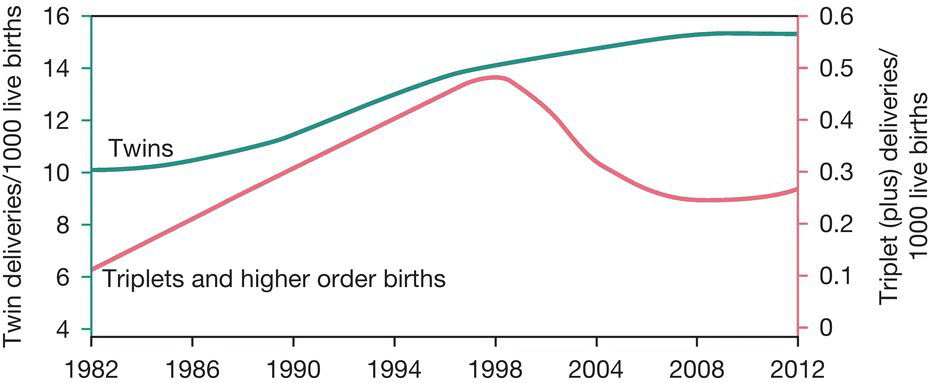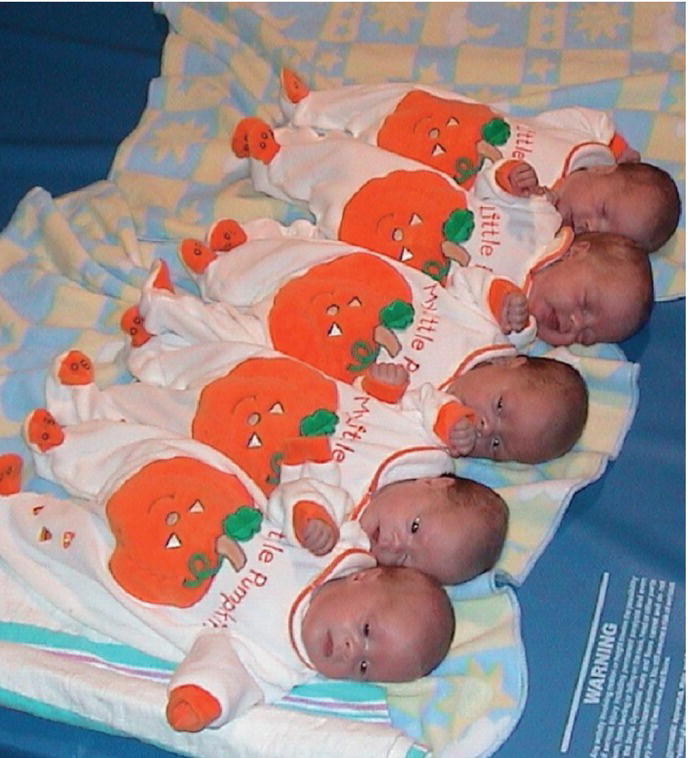7
Multiple births
The incidence of spontaneous multiple gestation is:
- 1 in 89 for twins
- 1 in 892 (1 in 8000) for triplets
- 1 in 893 (1 in 700 000) for quadruplets.
However, the number of multiple gestations has increased because of fertility enhancing therapies and the older age of childbearing. As a result, 1 in 64 births in the UK is a multiple birth; in the US it is 1 in 58 births. The rate of twin pregnancies has increased markedly since 1980, and was 15.3 per 1000 live births in the UK in 2012 (Fig. 7.1) and 16.8 per 1000 live births in the US in 2013. The number of triplets and higher order births rose markedly in the 1990s but has declined since then, following changes in assisted reproductive therapy practices.
Twins may:
- have their own chorionic sac and placenta (dichorionic, 67%)
- share a chorionic sac and placenta (monochorionic, 33%).
Ultrasound can show whether twins share a placenta (chorionicity) but not if they are identical (zygosity), which can often only be determined through DNA testing (Fig. 7.2).

Fig. 7.1 Change in the number of multiple births in the UK since 1980. There has been a marked increase in number of twin deliveries. The number of triplets and higher order deliveries increased markedly during the 1990s but have subsequently decreased. Changes in the US have followed a similar pattern, but at a higher rate for triplet and higher order births.
Pregnancy complications

Fig. 7.2 Relationship between chorionicity and zygosity in twins. Placentation of monozygotic twins depends on the stage at which the split occurs. Early splits are dichorionic, later splits are monochorionic.
The main pregnancy complications of twins are:
- Preterm delivery. The increased prematurity rate (Table 7.1) is responsible for the increase in perinatal mortality, which for twins is six times that of singletons. Monochorionic twins are at particularly increased risk of iatrogenic preterm delivery. In very high order pregnancies, selective fetal reduction reduces the rate of preterm delivery and perinatal mortality.
- Intrauterine growth restriction (IUGR). Severe IUGR, with inter-twin estimated fetal weight difference of >20%, affects 20% of dichorionic twins and 40% of monochorionic twins. If one twin has IUGR, the potential benefits of early delivery for that twin has to be weighed against the prematurity-related complications of the normally grown twin.
- Congenital abnormalities. In dichorionic twins the risk is twice normal, as there are two infants. However, in monochorionic twins the risk is four times normal. Anomalies may be discordant or concordant. There is a particularly increased risk of congenital heart disease.
- Twin–twin transfusion syndrome (TTTS). This occurs in approximately 10% of monochorionic twin pregnancies due to placental arteriovenous anastomoses. The ‘donor’ has low perfusion pressures, growth restriction, oliguria and oligohydramnios. The recipient twin experiences hypervolemia, which may result in high-output cardiac failure, polyuria and polyhydramnios. Before 26 weeks’ gestation, this may result in preterm labor or intrauterine death in up to 90% if untreated. Potential in utero treatment includes fetoscopic laser therapy to divide the placental blood vessels or periodic drainage of the amniotic fluid (amniodrainage). The latter is utilized in relatively mild disease presenting after 26 weeks’ gestation. Such cases require prenatal evaluation in a perinatal center by a fetal medicine subspecialist. Even when successfully treated, the infants may have anemia–polycythemia sequence (TAPS), where the hemoglobin difference at birth is >5 g/dL, and 5–10% of survivors have neurologic morbidity.
- Death of a fetus. Intrauterine death of one twin may result in preterm labor. In monochorionic twins (with associated placental anastomoses) there may be blood loss from the live to the dead twin, leading to hypovolemia, severe anemia, neurologic impairment (15–20%) or death of the surviving twin (20%). Mono-amniotic twins (Fig 7.2d) risk cord entanglement leading to hypoxia of one or both twins.Conjoined twins. If twinning of monozygotic twins occurs very late (>14th day) they may be conjoined, with fused skin or organs. Monozygotic twins may also demonstrate “mirroring” where they have opposite asymmetry of certain features.
Table 7.1 Peak gestation and mean birthweight for singleton and multiple births.
| Peak gestation (weeks) | Birthweight(mean, kg) | |
| Singleton | 40 | 3.5 |
| Twins | 37 | 2.5 |
| Triplets | 34 | 1.8 |
| Quadruplets | 32 | 1.4 |
Neonatal complications
For multiple preterm births, the immediate problem may be to identify sufficient intensive care capacity.
Apart from prematurity, other immediate medical problems may be twin–twin transfusion syndrome (anemia may require blood or exchange transfusion); polycythemia (may require exchange transfusion), IUGR and congenital malformations. Mortality of twins is over five times greater than for single births, for triplets it is increased 10-fold and for quadruplets more than 20-fold.
Families of multiple births may need additional assistance and support:
- Feeding – it is more difficult, but often possible, to breast-feed twins fully, but is usually not possible for higher order births.
- Practical – with their care and housework (requires about 200 h/week for triplets in infancy!); may require help to be able to leave the house (Fig. 7.3).
- Emotional – can be exhausting to provide care.
- Privacy – loss of privacy as a couple, and increased rate of separation and divorce.
- Financial – considerable additional costs (cannot hand down clothes or equipment), may need to move to larger living space.
- Increased incidence of parental depression, especially if there was fetal or neonatal loss (when every birthday or other achievement of the survivor is a reminder that the co-twin died).
- Behavioral – problems in other siblings are increased threefold.
- Development – reduced opportunities for mother–infant interaction, as mothers are busy and often tired. Increased risk of delayed language development and poor attention span. Although multiple births may provide companionship, affection and stimulation between each other, they may also engender domination, dependency and jealousy. The rate of disability is increased, e.g. the cerebral palsy rate for twins is 7 per 1000 live births and for triplets 27 per 1000 live births, compared to 1.6 per 1000 live births in singletons. This is mainly related to prematurity.

Fig. 7.3 Quintuplets. Multiple births look endearing but families may need assistance with their care.
There are local and national support groups for parents of multiple births.